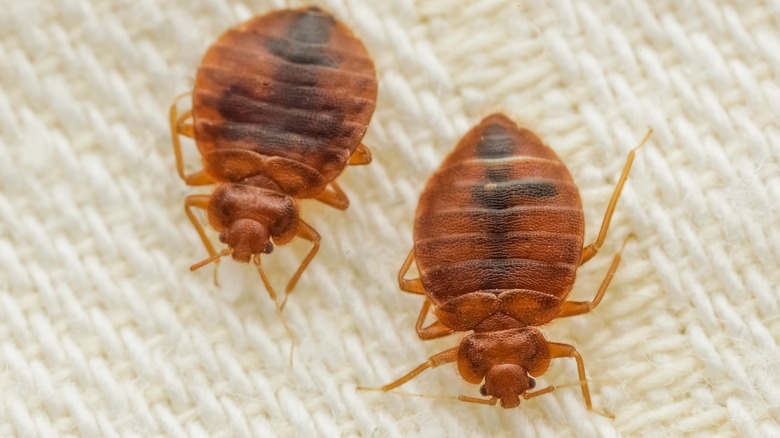Bed bugs have the ability to thrive in various living spaces like carpets, resulting in diverse bed bug populations in homes. Detecting signs of bed bugs in your carpet is essential for effectively removing them from the carpet. We will discuss a method for identifying bedbugs on your carpet in order to promptly address and prevent the infestation from spreading to other areas of your residence.
What Are Bed Bugs?
We will start with the scientifically known name for bed bugs – Cimex lectularius, which are small insects without wings that feed on the blood of humans and animals to survive. Once they are fully developed, they are brown and reach the size of an apple seed. Bed bugs are mainly active at night, feasting on their hosts as they sleep. Their inclination to hide in tiny crevices makes them challenging to find and remove, as they are notorious for seeking refuge in such spaces.
Тhat pests can endure long periods without food. Usually, bed bugs are located in places where individuals relax, like beds, mattresses, and carpets. They can effortlessly move by clinging onto objects like suitcases, chairs, and clothes. Bites, allergies, and severe psychological distress can all result from infestations. Rapidly identifying and handling bed bug infestations is essential in order to stop them from spreading.
Presence of Live or Dead Bed Bugs
You can tell that your carpet has a bed bug infestation by finding one of the following things, live or deceased bugs on its surface. When fully grown, it is roughly the dimensions of an apple seed, with an oval shape and a reddish-brown color. Verify the existence of bed bugs on the carpet by examining if they are moving. Areas treated for bed bug infestation could still contain dead bed bugs.
Take note of the unusual smells that bed bugs produce while they are alive or deceased. They emit a unique and potent musty smell, often described as sweet or sickly, and it is strongest in places with a high infestation. You can identify the existence of bed bugs in your carpet without seeing any bugs by noticing specific odours coming from them.

Blood Stains or Faecal Spots
Bed bugs might stain carpets with blood or faeces after they have fed on human blood. Blood stains are observed as small, rust-coloured dots, typically located on bedding, furniture, or carpets close to where feeding occurs. On the flip side, faecal spots are of a dark brown or black hue and look akin to minuscule ink spots. They might be seen on the top of the carpet or stuck within its strands.
Bed bugs are commonly located under the carpet and within the padding. Although bedbugs are typically located on the surface of the carpet, they can also dig into the backing or padding to deposit faeces, moulted skins, and eggs. Thoroughly examine these regions if you think the infestation is severe.
Shed Bed Bug Skins
Bed bugs are thought to moult their exoskeletons while growing and maturing. These shed skins are frequently visible as empty shells on your carpet as they moult or shed their exoskeletons. Bed bugs are typically found hiding in spots like along baseboards, underneath furniture, or in carpet seams. Search for these discarded skins in places where they are commonly found.
You need to keep an eye out for bed bug eggs, small pearl-white ovals often found in groups or lines in hidden spots along with moulted skins. Bed bug eggs are typically discovered in bunches or lines in hidden locations and should not be overlooked. If needed, use a magnifying glass to examine the carpet fibres for any eggs or egg casings that might be present.
Musty Odour
If you sense a musty or sweet smell coming from your carpet, you might be dealing with a major bed bug problem. The smell is caused by bed bugs and the pheromones they release along with their faeces. Detecting a smell could suggest a serious infestation that needs expert assistance, so it’s crucial to examine for additional bed bug indicators. Furthermore, a powerful, bad odour coming from your carpet suggests a serious infestation.
Even though bed bugs have been eliminated, the lingering musty odour connected to them can remain for many years post-eradication. To eliminate the odor and avoid future issues, the carpet must be cleaned and treated effectively, along with implementing preventative measures.
Bite Marks on Skin
Although bed bugs may not directly indicate their presence on a carpet, bite marks on the skin can be a reliable sign of their existence. Bed bug bites often manifest as red, itchy marks on uncovered parts of the body, like the arms, legs, neck, or face, in groups or rows. Whether your family is getting bitten or not, it’s crucial to check your carpet and bedding for bed bugs.
It is important to monitor potential allergic reactions or infections to bed bug bites to avoid health risks. If needed, get medical help for any potential symptoms. In case any of these happen, make sure to tackle the root cause of the infestation to avoid more bites and health hazards.

Conclusion
Bed bugs can be detected and treated quickly if you know how to look for them on your carpet. You can fix the problem quickly by looking for things like live or dead bed bugs, blood stains, faecal spots, shed skins, musty smells, bite marks, eggs or casings, and active nesting areas. If you think there are bed bugs in your carpet, consider reaching out to a bed bug control expert for help. Ensuring a bug-free environment in your home and a healthy living space for your family demands attentiveness and watchfulness from you.






